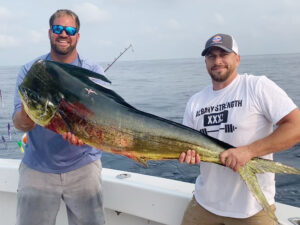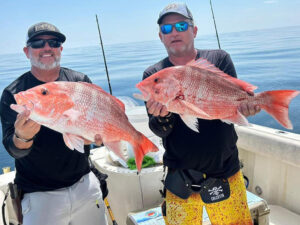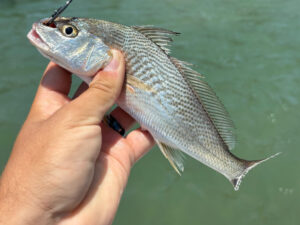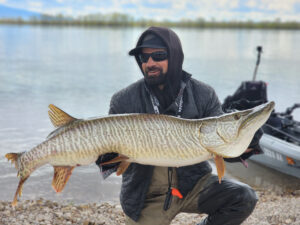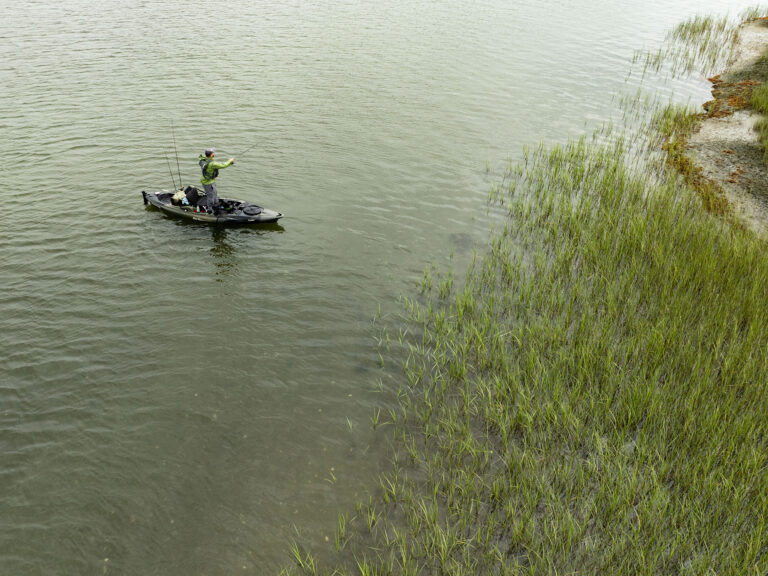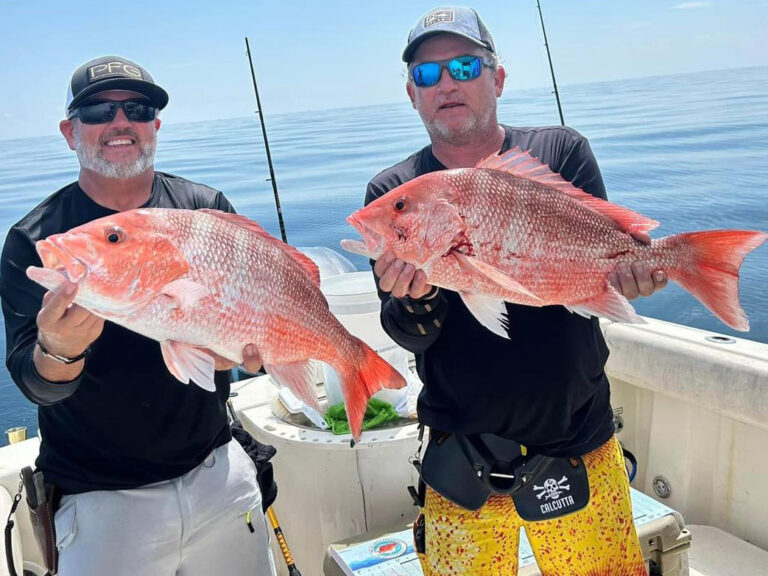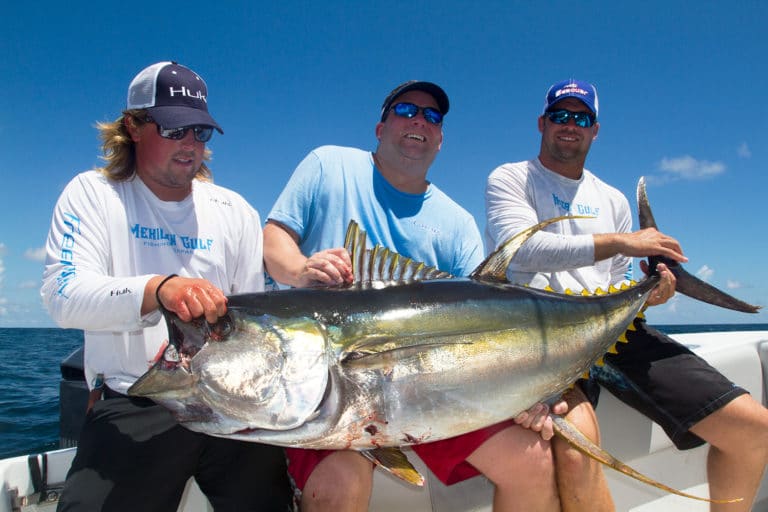This past June, Secretary of Commerce Wilbur Ross named Chris Oliver as assistant administrator for NOAA Fisheries. His responsibility is overseeing the National Marine Fisheries Service.
Oliver brings more direct fisheries-management experience to the role than some other recent appointees to head NMFS. The Texas native spent the past 27 years working with the North Pacific Fishery Management Council, first as a fisheries biologist, then deputy director and — for the past 16 years — as the council’s director.
Despite his experience, Oliver’s direction on policy matters of importance to the nation’s recreational anglers and attendant industries has not been well known. It’s the purpose of this exclusive interview to change that and begin to establish an idea of what we might expect from the latest head of NMFS.

Management Strategies, Commercial Vs. Recreational
SPORT FISHING:
Do you feel that commercial fisheries and recreational fisheries can and/or should be managed by NMFS with the same fundamental approach, or that very different management strategies are required for each? As a fisheries manager, what differences, if any, do you see between the way these two stakeholder groups use a resource that would or should require different management strategies?
CHRIS OLIVER:
First, thanks for the opportunity to share my thoughts with your readers. I am still getting my sea-legs here at NOAA Fisheries, but my experience in Alaska gave me a solid foundation for tackling the issues that concern both our recreational and commercial fishermen on a national level.
So, on to your questions. I think we can agree that commercial and recreational fishing are different, but both share the common need for sustainable, science-based management and access, and both are subject to the requirements of the Magnuson-Stevens Act. As businesses, commercial fishermen appropriately seek to harvest fish as quickly and efficiently as possible, minimizing costs and maximizing profits. Recreational anglers, on the other hand, fish to enjoy time on the water or spend time with family and friends. I believe we need to recognize these differences and, where appropriate, use different management approaches to ensure both communities thrive.
It think it is important to note that the Magnuson-Stevens Act was originally crafted as a commercial statute to Americanize fisheries occurring just off our shores and expand our domestic commercial fisheries – and it worked. However, applying the same tools used to achieve those goals and, more recently, rebuild depleted fish stocks, may not translate into successful management of recreational fisheries. Recognizing this, NOAA Fisheries was able to address a number of issues important to the recreational community, as well as the commercial fishing community, by adding additional flexibility for fishery managers as we revised the National Standard 1 Guidelines in 2016. This included greater flexibility to carry-over unused quota from one season to the next, use multi-year overfishing definitions, and determine rebuilding timelines, among others. More about National Standard 1 revisions can be found on our website.
NMFS Priorities in Managing Fisheries
SPORT FISHING:
As a follow-up to that question: Managing recreational fisheries was added to the responsibilities of this Department of Commerce agency long after it was created, primarily to look after the welfare of commercial fishing/fishermen in this country. In other words, managing recreational fisheries was an afterthought, and some insist that it still is, with NMFS committing neither effort nor funds necessary to manage recreational fisheries as effectively as it manages commercial fishing. To what extent do you feel that is a fair criticism?
CHRIS OLIVER:
I am glad you raised that question because I believe the criticism is outdated. The Magnuson-Stevens Act expressly acknowledges as one of its key purposes that “commercial and recreational fishing constitutes a major source of employment and contributes significantly to the economy of the Nation” and includes “promot[ion] of domestic commercial and recreational fishing under sound conservation and management principles….” My predecessors in this role took this seriously and I do, too. I believe NOAA Fisheries has made remarkable progress these past few years in focusing on building stronger relationships and greater capacity to help the recreational community. One good example is the appointment in 2010 of our national recreational fishing coordinator, Russ Dunn. His sole focus is to understand the needs of the recreational sector and ensure those needs are heard and considered at the highest levels of the agency.
I would also point out that recreational fishing is fully incorporated into the agency’s science and management programs through our National Saltwater Recreational Fisheries Policy. We also have national and region-specific recreational fisheries implementation plans with nearly 300 public commitments included, many of which have been accomplished or are underway. I am committed to continuing an open, face-to-face dialogue with leaders in the saltwater fishing community. To that point, I am pleased to share with your readers that we will host a second National Saltwater Recreational Fisheries Summit in Virginia in March 2018. The current Administration recognizes the importance of recreational fisheries and has made it a high priority to develop management programs appropriate to support those fisheries.
U.S. Department of the Interior Vs. Department of Commerce to Manage Recreational Fisheries?
SPORT FISHING:
And as another follow-up: Why is NMFS better off under the U.S. Department of Commerce umbrella vs. the U.S. Department of the Interior (which includes several federal agencies with responsibilities for managing fish and wildlife)?
CHRIS OLIVER:
The core mission of the Department of Commerce—promoting American business—makes it well suited to bolster the economic benefits of saltwater recreational fisheries. In 2015, spending on saltwater recreational fishing supported 439,000 jobs, drove $63 billion in sales impacts, and contributed $36 billion to the national gross domestic product. Each of these economic markers has steadily increased since 2012, showing the positive effects of rebuilding overfished stocks. The Department of Commerce and NOAA understand that recreational fishing is big business and are committed to continuing this positive trend.
Also, the successful management of our oceans, coasts, and marine resources—including fisheries—requires highly integrated information-sharing and decision-making with partners at every level. NOAA has an institutional capacity and infrastructure unlike any other, enabling it to collect and analyze needed oceanographic and biological information. This comprehensive and robust marine fisheries science capacity does not exist within Interior, and it allows NOAA Fisheries, in conjunction with our state and federal partners, to better meet our mandates under the law.
Would Changes to MSA Empty the Oceans of Fish?
SPORT FISHING:
Recently, legislation has been working its way through both houses that would amend federal fisheries law (the Magnuson-Stevens Act, or MSA) in a way that recreational fishing interests would say finally recognizes their needs without removing built-in safeguards for marine fish stocks. However, some environmental groups insist such changes to the MSA would “empty the oceans” of fish. What are your thoughts on amending MSA?
CHRIS OLIVER:
I have gone on record as supportive of additional flexibility, particularly in fisheries for which real-time catch accounting data is not feasible, this includes most recreational fisheries. As a longtime director of the North Pacific Fishery Management Council, I can tell you from first-hand experience that the MSA has provided an invaluable and effective platform for ending overfishing and rebuilding overfished fisheries. It is because of the MSA that U.S. fisheries enjoy a global reputation of being responsibly managed and sustainable, and are considered the gold standard for the rest of the world. At the end of 2016, 91% of stocks for which we have assessments are not subject to overfishing and 84% are not overfished. However, there are challenges under the MSA as it is currently constructed, for some commercial fisheries, and particularly for recreational fisheries.
No one—whether recreational, commercial, or environmental organizations, or fishery managers—wants to see the oceans emptied of fish; however, some provisions, such as annual catch limits and accountability measures, have posed a major challenge for recreational fisheries and data-poor stocks. My perspective is that the regional fishery management Councils, which includes recreational and commercial fishermen, and others with local, on-the-water knowledge, are best positioned to resolve these sorts of challenges, given the necessary tools from Congress.
I look forward to working with Congress, the Councils, and the recreational and commercial fishing industries to determine what additional flexibility would be appropriate—without compromising the health of our fisheries resources.
State Vs. Federal Management of Coastal Fisheries?
SPORT FISHING:
Thanks in part to issues with federal management of recreational red snapper fisheries in the Gulf of Mexico, there is an increasing push at a grassroots level as well as in pending legislation to allow states to assume more responsibility for fisheries now strictly within federal management jurisdiction. What are your thoughts on this?
CHRIS OLIVER:
The bottom line here is that Gulf red snapper is a complex issue, and it’s one that Secretary of Commerce Wilbur Ross is invested in quickly resolving. In June, he negotiated with the five Gulf states to align their state water seasons with an extended federal season, which is a significant step forward in reducing confusion on the water by harmonizing federal-state fishing seasons and furthering the federal-state partnership.
From a purely biological perspective, it’s important not to lose sight: Gulf red snapper is a “good news” story. Under the Gulf Council’s rebuilding plan, the stock has rebounded and there are more fish, bigger fish, and fish in more places—just what fishermen asked for 10 years ago.This allowed total allowable catches to be set at record high levels, rising from 5 million pounds to more than 14 million pounds between 2008 and 2014.
Here is the hitch: Because the fish were heavier, more abundant, and easier to catch, the quotas were filled even faster than they increased, and this, along with extended state waters seasons, led to decreasing seasons in federal waters. I share the frustration of anglers who have lost days in federal waters as the stock rebounds, and I am confident that by using science to guide management decisions we will be able to rebuild the species fully.
We are on the record in a number of instances supporting a greater role for the states through the framework of the MSA, for red snapper as well as other species, and we will continue to support this approach. We will be meeting in the coming weeks with the Gulf states fisheries directors to discuss this and other management issues related to red snapper. Additionally, we and the South Atlantic Council are currently in talks with the Atlantic States Marine Fisheries Commission about increasing the Commission’s role in managing Atlantic cobia.
Can Anglers Contribute to Federal Catch-Data Collection?
SPORT FISHING:
Many anglers are eager to provide voluntary electronic data to improve management, and states (such as Florida) have used catch data from anglers’ smartphones to improve stock assessments. Yet NMFS has not embraced the use of this technology, despite the major, acknowledged limitations of current sport-fishing data collection and the tremendous potential of electronic data. Do you believe NMFS should work with the recreational fishing community to explore voluntary electronic data as a supplemental federal data collection program?
CHRIS OLIVER:
That’s a great question, and while it is more complicated than flipping a switch, the answer is yes, we support use of electronic technologies to augment our recreational catch and effort data collection system, and I have made it a priority to get the state data collection programs certified for use. However, we need to be thoughtful and smart about how we do so to ensure that the data we get back are useful for science and management and, importantly, have the confidence of fishermen.
The technology is there, but there are real challenges related to the statistical soundness of voluntary self-reported data that need to be resolved first. I know that advancing electronic technologies has been a consistent focus of NOAA Fisheries and our recreational fishing stakeholders for many years. For example, NOAA Fisheries has supported pilot studies testing potential ways to collect and use data from smartphones, and late last year we adopted a directive on electronic reporting as a priority for funding. We know it is a priority for the recreational community and will continue to work with them, our state partners, and other stakeholders to look at ways to expedite the use of smartphone reporting.
Outlook for Budget Cuts in Fisheries
SPORT FISHING:
What sort of budgetary cuts do you anticipate for NMFS? Where—in what programs —will you effect reductions?
CHRIS OLIVER:
The President’s 2018 budget blueprint identified fisheries management as a priority. I am also confident that sustaining our fisheries for generations to come is not just an Administration priority, but a bipartisan priority for Congress, the regional fishery management Councils, and all fishing interests. Some re-prioritization of focus and efforts is unavoidable, and we will need to align available resources with core, mission-critical activities such as basic stock assessment and catch accounting to meet Congressional direction.
Outlook for Significant Changes?
SPORT FISHING:
Can you offer any insight into areas of significant changes you plan to make or would like to see in NMFS policy/actions during your tenure?
CHRIS OLIVER:
One goal of the Secretary of Commerce, which I share, is seeing the United States make progress in expanding U.S. seafood production and exports, particularly through aquaculture and mariculture. It is quite alarming that more than 80% of the seafood we consume is imported. I believe our country is uniquely positioned to conduct more fish farming in offshore waters.
From the recreational fisheries perspective, increased stability and predictability in fishing seasons and opportunities has to be a priority. There is no single change I see that can achieve this, but likely a series of improvements—in recreational data and how those data are applied, flexibility under the law, innovative management approaches, and collaboration with coastal states. And, as I’ve said, I think that local and regional decision-makers are best equipped to figure this out, within overarching guidance from Congress, but increased stability is essential.
Consistent with numerous recent Presidential Executive Orders, I also hope to see improvements and efficiency gains in our institutional agency structures, as well as our various regulatory processes, through these agency and regulatory reform initiatives.
On Reducing Release Mortality
SPORT FISHING:
In a 2014 interview, I asked a predecessor of yours, then-NMFS Administrator Eileen Sobeck, why more fishery management councils aren’t encouraging the use of release tools to minimize barotrauma mortality in deepwater fishes such as red snapper. The response basically indicated that NMFS would continue to evaluate options. Now, nearly four years later, the Gulf of Mexico Fishery Management Council still doesn’t require the use of these proven devices that could save a great many fish released to simply float away and die. Are you aware of this issue?
CHRIS OLIVER:
Absolutely, Alaska and the Pacific Coast states have been great advocates of addressing release mortality in partnership with the recreational community. NOAA Fisheries understands that reducing the mortality associated with released fish is an important tool for limiting the ecological footprint of the recreational fishery, and may, under some circumstances, allow for additional fishing opportunities.
Release mortality remains an important focus for the agency, and we have continued to work on this since your 2014 interview. For example, the agency organized and co-chaired a symposium on release mortality at the American Fisheries Society meeting in the summer of 2014, released an Agency Action Plan for Fish Release Mortality Science in 2016, and in July of this year organized and co-chaired another scientific symposium on the subject at the World Recreational Fisheries Conference.
As you know, the Gulf Council removed a venting tool requirement of questionable ecological value a few years ago, and as I understand it is now considering requiring descending devices to reduce release mortality. I think there are differing opinions about whether it is best to mandate that anglers possess and use descending devices, or whether anglers should be made aware of the benefits of doing so and left to make the choice for themselves.
Should Catch Shares Manage Recreational Fishing?
SPORT FISHING:
The use of catch shares (via individual fishing quotas) has grown contentious, with some groups pushing hard for their adoption in all or most fisheries. What’s your take on: (1) the criticism that IFQs give away to an elite few a public resource at no cost (unlike other public resources, such as oil, timber or —???, the rights for which private entities must pay)? and (2) the push to manage recreational fisheries (red snapper, for example) on a catch share basis?
CHRIS OLIVER:
Catch share programs are just one management option Councils can choose to meet their management objectives. We have had substantial success with catch share programs in the North Pacific, though many of those programs are in larger, more industrialized commercial fisheries. Catch shares are neither required nor appropriate for every fishery. Ensuring regional fishery management Councils have flexibility to tailor their management plans to maximize fishing opportunities is important to our continued success.
It will come as no surprise that I am a big believer in the Council system, and a big believer in regional solutions to regional problems. I am not a big fan of one-size-fits-all approaches that may not fit very well with the specific conditions of very different fisheries across the country. While catch share programs are a very effective tool for many fisheries, I personally do not believe that private recreational fisheries lend themselves well to this management tool, and we need to focus our collective efforts on other, more appropriate management approaches for these fisheries.

